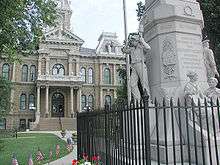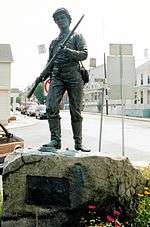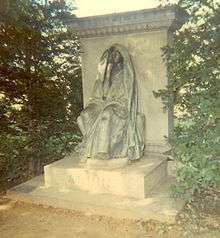Edward Ludwig Albert Pausch
Edward Ludwig Albert Pausch (September 30, 1856 – 1931) was a Danish-American sculptor noted for his war memorials.[1]
Life
He was born in Copenhagen, Denmark, the son of Henry and Annette P. Pausch. The family emigrated to Hartford, Connecticut when he was a child. He apprenticed for eleven years under Carl Conrads in Hartford, beginning at age 14. He studied under Domingo Mora in New York City for six years, and under Karl Gerhardt in Hartford for three years. In 1889, he joined sculptor J. G. Hamilton at the Smith Granite Company in Westerly, Rhode Island. He opened his own studio in Hartford in 1900, and moved it to Buffalo, New York the following year.[2] He married Julia Ellenberger of Hartford in 1878.
Within hours of President William McKinley's assassination on September 14, 1901, Pausch was summoned from Hartford to Buffalo to make the death mask. He began work the following morning, and completed it in about a month.[3] He later used it to model his McKinley statue (1903–05) in Reading, Pennsylvania.
His most ambitious work is the George Washington Memorial (1889–91) in Pittsburgh, Pennsylvania. A one-and-one-half-lifesize equestrian statue carved out of granite, it depicts Washington as a 23-year-old colonel in the French and Indian War.[4] Pausch modeled the head on Houdon's bust.
His most infamous work, Black Aggie (1906–07), is an unauthorized near-copy of Augustus Saint-Gaudens's 1891 Adams Memorial. General Felix Agnus thought he was ordering a casting from Saint-Gaudens's original molds for his family plot in Druid Ridge Cemetery, Pikesville, Maryland. John Salter, a granite supplier in Connecticut, misled Agnus and hired Pausch to model the freehand bronze copy.[5] Saint-Gaudens's widow sued Salter, and won a court judgment. Pausch's actions were publicly denounced by sculptors such as Karl Bitter and Daniel Chester French, which dealt a serious blow to his professional reputation.[6] The bootleg statue remained in the cemetery, and became the subject of ghost stories and urban legends. Following repeated acts of vandalism, it was removed and donated to the Smithsonian Institution in 1967 (as a work by Saint-Gaudens). Deaccessioned, it is now installed in the courtyard between the Cutts-Madison House and the National Courts Building in Washington, D.C.[7]
His studio was located at Delaware & Delavan Avenues in Buffalo, New York.[8] He exhibited at the Albright Art Gallery in 1919.[9] Among his students were sculptors Robert D. Barr, Stanley Edwards, and William Stephenson.[10]
The spelling of Pausch's first name alternates between "Edward" and "Eduard."
Selected works

- Equestrian Statue of George Washington, George Washington Memorial (1889–91), Allegheny Commons Park, Pittsburgh, Pennsylvania.[11]
- Death mask of President William McKinley (1901), Smithsonian Institution, Washington, D.C.
- Bust of President William McKinley (1902), Main Post Office, Philadelphia, Pennsylvania.[12]
- President William McKinley, McKinley Memorial (1903–05), City Park, Reading, Pennsylvania.[13]
- Black Aggie, Agnus Memorial (circa 1906–07), Druid Ridge Cemetery, Pikesville, Maryland.[14] Relocated to the Cutts-Madison House, Washington, D.C.
- Bust of Elbert Hubbard (1916), McLean County Historical Society, Bloomington, Illinois.[15]
Soldiers' monuments

- Seneca County Soldiers' Monument (1884–85), Frost Parkway, Tiffin, Ohio.[16]
- Soldiers' Monument (1889), St. Bernard Cemetery, New Haven, Connecticut.[17][18]
- Soldiers' Memorial Monument (1890–91), Diamond Park, Meadville, Pennsylvania.[19]
- Mecosta County Soldiers' Monument (1893), Mecosta County Courthouse, Big Rapids, Michigan.[20]
- Ypsilanti Civil War Memorial (1895), Highland Cemetery, Ypsilanti, Michigan.[21]
- Rhode Island Soldiers Home Monument (1901–02), North Burial Ground, Bristol, Rhode Island.[22]
- Guernsey County Soldiers' Monument (1902–03), Guernsey County Courthouse, Cambridge, Ohio.[23]
- Broadway Civil War Monument (1905), Broadway Triangle, 318 Elm Street, New Haven, Connecticut.[24] Pausch modeled the Artilleryman figure; Stanley Edwards modeled the Infantryman figure.
Battlefield monuments

Smith Granite Company created at least fifty-seven monuments for the Gettysburg Battlefield,[25] and at least sixteen monuments for Chickamauga and Chattanooga National Military Park.[26][27] Those that have been documented to Pausch are listed below. Van Amringe Granite Company (sub-contracting with Smith Granite Company) created six monuments for the Antietam Battlefield, all documented to Pausch.
Gettysburg Battlefield, Gettysburg, Pennsylvania
- 13th Massachusetts Volunteer Infantry Monument (1885), Robinson Avenue.[28]
- 26th Pennsylvania Emergency Militia Monument (1892), Chambersburg Pike & West Street.[29]
Chickamauga and Chattanooga National Military Park
- 10th Wisconsin Infantry Monument (1895).[30]
- 77th Pennsylvania Infantry Regiment Monument, Brock's Field (1897).[31]
- 3rd Maryland Infantry & Latrobe's Battery Monument, Orchard Knob (1902–03).[32] The monument's base originally featured two soldier figures, one Union and one Confederate, but these were removed after repeated vandalism.
- Ohio State Monument, Missionary Ridge (1902–03).[33]
- 7th Pennsylvania Cavalry Monument (circa 1905).[34]
Antietam Battlefield, Sharpsburg, Maryland
- 12th Pennsylvania Cavalry Monument (1904).[35]
- 45th Pennsylvania Volunteer Infantry Monument (1904).[36]
- 51st Pennsylvania Volunteer Infantry Monument (1904).[37]
- 125th Pennsylvania Infantry Monument (1904).[38]
- "Durell's Battery," Independent Battery D, Pennsylvania Artillery Monument (1904).[39]
- 128th Pennsylvania Volunteer Infantry Monument (circa 1905).[40]
 77th Pennsylvania Infantry Regiment Monument (1897), Chickamauga and Chattanooga National Military Park.
77th Pennsylvania Infantry Regiment Monument (1897), Chickamauga and Chattanooga National Military Park. Death mask of President William McKinley (1901).
Death mask of President William McKinley (1901). Rhode Island Soldiers Home Monument (1901–02), Bristol, Rhode Island.
Rhode Island Soldiers Home Monument (1901–02), Bristol, Rhode Island. 12th Pennsylvania Cavalry Monument (1904), Antietam Battlefield.
12th Pennsylvania Cavalry Monument (1904), Antietam Battlefield. 7th Pennsylvania Cavalry Monument (circa 1905), Chickamauga and Chattanooga National Military Park.
7th Pennsylvania Cavalry Monument (circa 1905), Chickamauga and Chattanooga National Military Park.
References
- ↑ "Pausch, Edward Ludwig Albert," The Artists Year Book (Art League Publishing Association, 1905).
- ↑ Edward Pausch to F. Edwin Elwell, 15 July 1903, from Metropolitan Museum of Art Libraries.
- ↑ "The McKinley Death Mask," The New York Times, November 19, 1901.
- ↑ Washington Equestrian Statue, from Babcock-Smith House Museum.
- ↑ Daniel B. Krinsley, "An Unexpected Rendezvous at the Cosmos Club on Lafayette Square," COSMOS Journal (1998).
- ↑ C.J. Mills, The Adams Memorial and American Funerary Sculpture, 1891–1927. University of Maryland: Doctoral Dissertation, 1996, pages 218-19, 223-26.
- ↑ John Kelly, "'Black Aggie': D.C. statue cloaked in superstition," The Washington Post, August 18, 2012.
- ↑ "Pausch, Eduard L. A.," American Art Directory (1903).
- ↑ Sir Humphry Davy, "Art in Every Day Life." (1919).
- ↑ Thomas A. O'Connell, "The Westerly Project, A Critical Review," from Babcock-Smith House Museum.
- ↑ George Washington Memorial, from SIRIS.
- ↑ "A McKinley Monument, Philadelphia," The Monumental News (February 1902), p. 117.
- ↑ President William McKinley, from SIRIS.
- ↑ Agnus Memorial, from SIRIS.
- ↑ Bust of Elbert Hubbard, from SIRIS.
- ↑ Seneca County Soldiers' Monument, from Babcock-Smith House Museum.
- ↑ Soldiers' Monument, from SIRIS.
- ↑ Soldiers' Monument, St. Bernard Cemetery, from Connecticut's Civil War Monuments.
- ↑ Soldiers' Memorial Monument, from SIRIS.
- ↑ Mecosta County Soldiers' Monument, from Babcock-Smith House Museum.
- ↑ Ypsilante Civil War Memorial, from Babcock-Smith House Museum.
- ↑ Rhode Island Soldiers Home Monument, from SIRIS.
- ↑ Guernsey County Soldiers' Monument, from Babcock-Smith House Museum.
- ↑ Broadway Civil War Monument from Babcock-Smith House Museum.
- ↑ Gettysburg National Military Park, from Babcock-Smith House Museum.
- ↑ Chickamauga Battlefield, from Babcock-Smith House Museum.
- ↑ Chattanooga Battlefield, from Babcock-Smith House Museum.
- ↑ 13th Massachusetts Volunteer Infantry Monument, from Babcock-Smith House Museum.
- ↑ 26th PA Emergency Militia Monument, from Babcock-Smith House Museum.
- ↑ 10th Wisconsin Infantry Monument, from Babcock-Smith House Museum.
- ↑ Pennsylvania Chickamauga-Chattanooga Battlefields Commission, Pennsylvania at Chickamauga and Chattanooga (1897), p. 193.
- ↑ 3rd Maryland Infantry Monument, from Maryland in the Civil War.
- ↑ Ohio State Monument, from Babcock-Smith House Museum.
- ↑ 7th PA Cavalry Monument, from Babcock-Smith House Museum.
- ↑ 12th PA Cavalry Monument, from SIRIS.
- ↑ 45th PA Volunteer Infantry Monument, from Babcock-Smith House Museum.
- ↑ 51st PA Volunteer Infantry Monument, from Babcock-Smith House Museum.
- ↑ 125th PA Infantry Monument, from Babcock-Smith House Museum.
- ↑ Durell's Battery PA Artillery Monument, from Babcock-Smith House Museum.
- ↑ 128th PA Volunteer Infantry Monument, from Babcock-Smith House Museum.
| Wikimedia Commons has media related to Edward Ludwig Albert Pausch. |